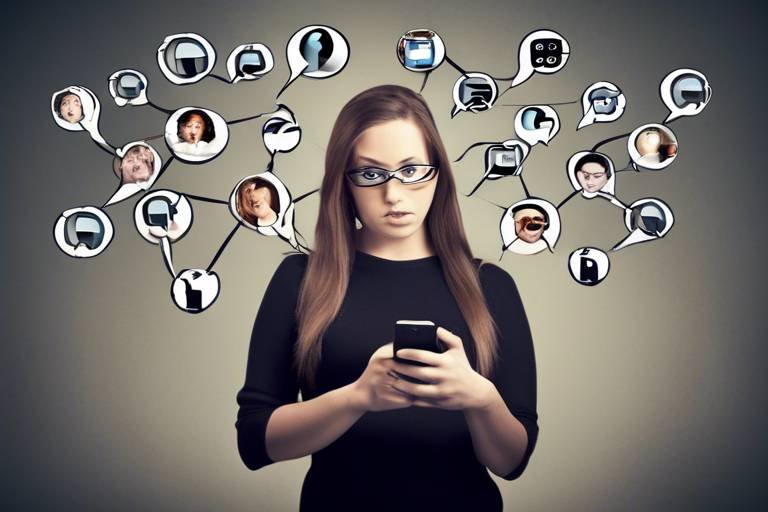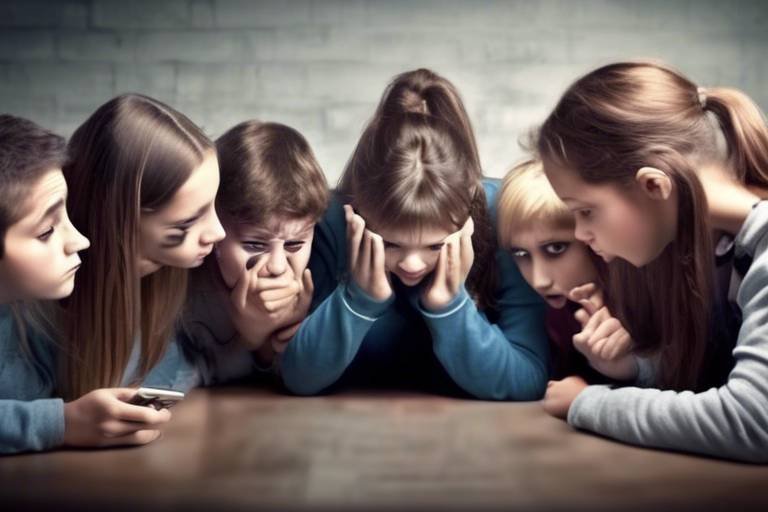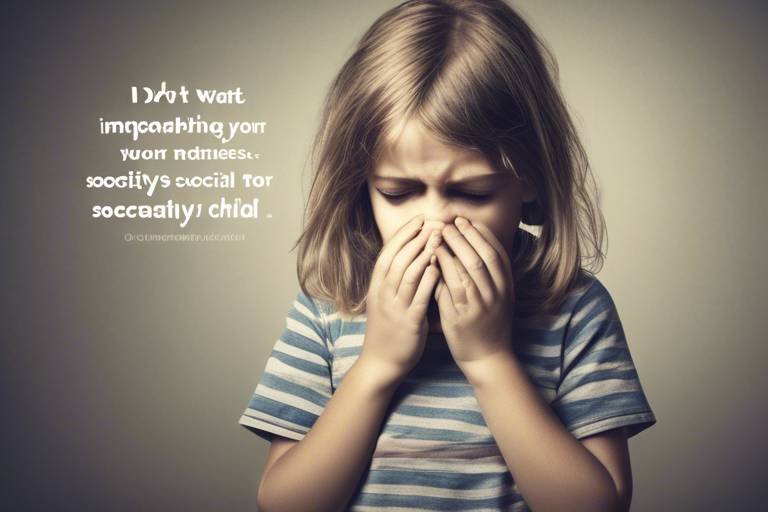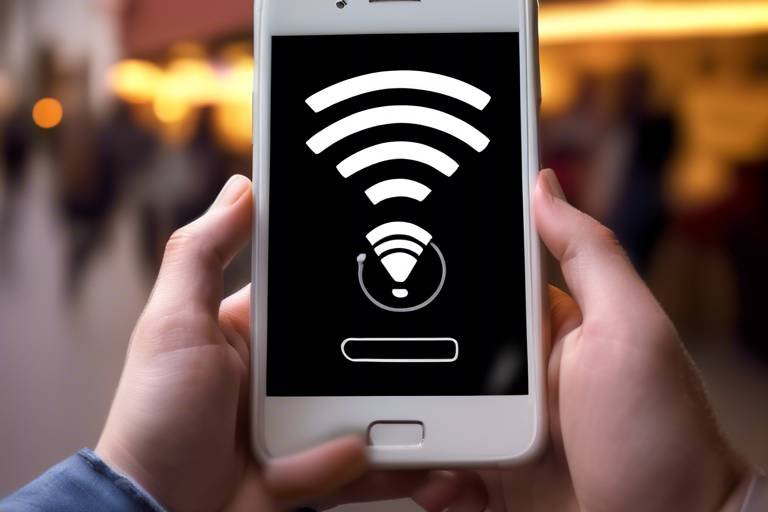Understanding the Risks of Social Media Networking
In today's digital age, social media has become an integral part of our lives. It's where we connect, share, and engage with friends, family, and even strangers from across the globe. However, as we dive deeper into this virtual world, it's essential to recognize that with great connectivity comes great responsibility. The risks associated with social media networking are not just trivial; they can have profound implications on our privacy, mental health, and overall well-being. So, what are these risks, and why should we care? Let’s explore the darker side of social media and arm ourselves with the knowledge to navigate it safely.
One of the most pressing issues in the realm of social media is privacy concerns. Many users often underestimate the importance of their privacy settings. Have you ever thought about who can see your posts or what happens to your data after you hit 'send'? The reality is that failing to manage your privacy effectively can lead to potential data breaches and misuse of personal information. For instance, personal details shared online can be exploited by malicious actors, leading to identity theft or fraud. It’s crucial to regularly review your privacy settings and be mindful of the information you share. Remember, once something is online, it can be nearly impossible to erase it completely.
As social media platforms have grown, so has the unfortunate phenomenon of cyberbullying. This form of harassment can take many shapes, from mean comments to spreading rumors, and it can have devastating effects on individuals, particularly young users. Imagine being tormented every day by peers, not just in person but online, where the harassment can feel relentless and inescapable. To combat this issue, it’s essential to not only recognize its impact but also to take proactive steps to create a safer online environment.
Recognizing the signs of cyberbullying is the first step toward prevention. Cyberbullying can manifest in various ways, including:
- Receiving threatening or demeaning messages.
- Being excluded from online groups or activities.
- Having personal information shared without consent.
If you or someone you know is experiencing these behaviors, it’s crucial to take action. Awareness is key to stopping the cycle of abuse.
Understanding how to report cyberbullying incidents can empower victims. Most social media platforms have built-in reporting mechanisms that allow users to flag inappropriate content or behavior. If you find yourself or a friend in a situation involving online harassment, don’t hesitate to:
- Document the evidence by taking screenshots.
- Report the user or content through the platform’s reporting tool.
- Reach out to trusted friends or family for support.
Accessing support resources can significantly help victims of cyberbullying. Organizations like StopBullying.gov and the National Suicide Prevention Lifeline offer valuable assistance and guidance. Remember, you are not alone, and there are people ready to help you through this tough time.
Cyberbullying can have serious legal consequences. Laws surrounding online harassment vary by location, but many jurisdictions are now recognizing the need for legal recourse in these situations. Social media platforms also have a responsibility to address and mitigate harmful behaviors. It’s essential for users to be aware of these laws and the potential repercussions of their actions online.
Another significant risk associated with social media is the rapid spread of misinformation. In a world where a single tweet can influence public opinion, the challenge of identifying credible sources has never been more critical. Misinformation can lead to misguided beliefs and actions, affecting everything from health decisions to political views. So, how can we navigate this landscape of false information?
Being able to discern misinformation is vital for informed decision-making. Here are a few tips to help you identify unreliable information online:
- Check the source: Is it reputable?
- Look for supporting evidence: Are there credible references?
- Beware of sensational headlines: They often exaggerate the truth.
Social media companies play a crucial role in addressing misinformation. Many platforms have implemented strategies and policies aimed at curbing the spread of false information. This includes fact-checking initiatives and partnerships with credible organizations. However, users must also take responsibility for verifying the information they encounter.
Lastly, let’s talk about the profound effects social media can have on our mental health. While it can foster connections and provide a sense of community, excessive use can lead to negative psychological consequences. From anxiety to depression, the implications are serious and warrant attention. Have you ever scrolled through your feed and felt a pang of jealousy or inadequacy? You're not alone.
Social comparison is a common issue on social media that can lead to feelings of inadequacy. Constantly comparing ourselves to the curated lives of others can distort our self-image and body image. It's essential to remember that what we see online is often just a highlight reel, not the full story.
Excessive screen time is linked to various mental health issues. Setting boundaries for healthier social media habits can make a significant difference. Consider implementing strategies like limiting your daily usage or taking regular breaks to reconnect with the real world. Your mental health will thank you!
Q: What can I do to protect my privacy on social media?
A: Regularly review your privacy settings, be cautious about the information you share, and consider using two-factor authentication for added security.
Q: How can I support someone who is being cyberbullied?
A: Offer a listening ear, encourage them to report the behavior, and help them seek professional support if needed.
Q: What should I do if I encounter misinformation online?
A: Verify the information through credible sources and report it if it is false or misleading.
In conclusion, while social media offers incredible opportunities for connection and expression, it's vital to be aware of the risks it poses. By understanding these risks and taking proactive measures, we can enjoy a safer and more fulfilling online experience.

Privacy Concerns
In the digital age, where our lives are increasingly intertwined with social media, have become more pressing than ever. Many users dive into social platforms without fully understanding the implications of their privacy settings. It’s almost like leaving your front door wide open while you’re away; you’re inviting unwanted guests into your personal space. The reality is that when you share your thoughts, photos, and even your location online, you are potentially exposing yourself to a myriad of risks, from data breaches to identity theft.
One of the biggest misconceptions is that social media platforms will automatically protect your personal information. However, the truth is that most users fail to adjust their privacy settings, leaving their profiles open to the public. This can lead to significant issues, such as targeted advertising, unsolicited contact from strangers, or even malicious activities. For instance, did you know that a simple post sharing your location could alert someone to your absence from home? It’s crucial to be aware of what you’re sharing and who can see it.
To illustrate the importance of managing privacy effectively, let’s consider a few key aspects:
- Data Breaches: Major social media platforms have experienced data breaches in the past, exposing millions of users' personal information. This not only puts individuals at risk but also undermines trust in these platforms.
- Misuse of Information: Information shared online can be used for malicious purposes, including stalking or harassment. Once something is posted on the internet, it can be nearly impossible to erase it completely.
- Privacy Settings: Users should regularly review and update their privacy settings to control who can see their content. It’s essential to understand the difference between public and private profiles, and what information is visible to friends versus strangers.
Furthermore, the implications of poor privacy management extend beyond just individual users. Companies and organizations can also suffer significant reputational damage if their data handling practices are found lacking. This highlights the need for both users and platforms to take privacy seriously. The responsibility lies not only in the hands of the individual but also with the social media companies to provide clear guidelines and tools for users to protect their privacy.
As we navigate through the complexities of social media, it’s imperative to stay informed and proactive. Regularly updating passwords, being cautious about friend requests, and understanding the terms of service can go a long way in safeguarding your personal information. Remember, your online presence is a reflection of you, and protecting it should be a top priority.
- What are the best practices for managing privacy on social media? Regularly review your privacy settings, limit the personal information you share, and be cautious about friend requests and public posts.
- How can I report a privacy violation on social media? Most platforms have reporting mechanisms in place. Look for options in the settings or help sections of the site.
- What should I do if my data has been compromised? Change your passwords immediately, enable two-factor authentication, and monitor your accounts for unusual activity.

Cyberbullying
In today's digital age, the rise of social media has unfortunately paved the way for an alarming increase in incidents. Unlike traditional bullying, which often occurs in physical spaces like schools or playgrounds, cyberbullying takes place in the vast realms of the internet, making it more pervasive and, at times, more insidious. Imagine being in a crowded room, yet feeling utterly alone as hurtful words and images are shared about you across various platforms. It's a nightmare that many individuals, especially young people, face daily.
Cyberbullying can manifest in various forms, from hurtful comments on social media posts to the sharing of embarrassing photos without consent. The anonymity that the internet provides often emboldens bullies, allowing them to strike without fear of immediate repercussions. This type of harassment can leave deep emotional scars, leading to feelings of isolation, anxiety, and even depression. It's essential to recognize that the impact of cyberbullying can be devastating, affecting not only the victim but also their friends and family.
One of the most challenging aspects of addressing cyberbullying is that it can often go unnoticed. Victims may feel ashamed or fearful about reporting the behavior, leading to a cycle of silence that allows the bullying to continue unchecked. This is where awareness and education come into play. Understanding what constitutes cyberbullying is the first step in combating it. Here are some common forms of cyberbullying:
- Harassment: Repeatedly sending offensive messages.
- Impersonation: Pretending to be someone else online to spread lies or rumors.
- Exclusion: Intentionally excluding someone from online groups or activities.
- Outing: Sharing someone’s private information without their consent.
Recognizing these behaviors is crucial for prevention and intervention. If you or someone you know is experiencing cyberbullying, it’s vital to take action. This leads us to the next important aspect of tackling this issue: understanding how to report cyberbullying incidents. Many social media platforms have built-in mechanisms for users to report abusive behavior. Familiarizing yourself with these tools can empower victims to take control and seek help.
Moreover, accessing support resources can make a significant difference for those affected by cyberbullying. Numerous organizations and hotlines are dedicated to providing assistance, offering everything from counseling to legal advice. Knowing where to turn can alleviate some of the burdens that come with being a victim of online harassment.
In conclusion, cyberbullying is a pervasive issue that demands our attention and action. By raising awareness, educating ourselves and others, and utilizing available resources, we can create a safer online environment for everyone. Remember, if you see something, say something; together, we can combat cyberbullying and support those who are suffering in silence.
Q1: What should I do if I am being cyberbullied?
A1: It's crucial to document the incidents, report them to the platform, and seek support from friends, family, or professional resources.
Q2: How can I help a friend who is being cyberbullied?
A2: Be there for them, listen to their concerns, encourage them to report the bullying, and help them find support resources.
Q3: Are there legal consequences for cyberbullying?
A3: Yes, many jurisdictions have laws against cyberbullying, and perpetrators can face serious legal repercussions.

Identifying Cyberbullying
In today's digital age, where social media is an integral part of our lives, cyberbullying has emerged as a significant issue that can have devastating effects on individuals, particularly young people. But how can we identify cyberbullying? Recognizing the signs is crucial for prevention and intervention. It's not always easy, as the nature of online interactions can often mask harmful behaviors. However, there are specific indicators that can help pinpoint when someone is being bullied online.
One of the most common signs of cyberbullying is a noticeable change in behavior. If a friend or family member suddenly becomes withdrawn, anxious, or starts avoiding online interactions, it could be a red flag. Additionally, look out for changes in their mood or attitude when discussing social media. If they seem upset or distressed by online interactions, it's essential to take these feelings seriously.
Another critical aspect to consider is the content of the messages being exchanged. Cyberbullying often manifests through hurtful messages, threats, or derogatory comments. If you notice someone receiving messages that are consistently negative or hostile, this could indicate bullying. It's important to pay attention to the frequency and intensity of these interactions.
Furthermore, cyberbullying can take many forms, including:
- Harassment: Repeatedly sending offensive, rude, and insulting messages.
- Impersonation: Pretending to be someone else to damage their reputation or credibility.
- Exclusion: Intentionally excluding someone from an online group or activity, which can lead to feelings of isolation.
- Outing: Sharing someone’s private information or secrets without their consent.
It's also important to note that cyberbullying can occur across various platforms, including social media sites, messaging apps, and online gaming communities. Therefore, being aware of the context and the platforms used is crucial. Encouraging open conversations about online experiences can help individuals feel more comfortable sharing their problems and seeking help.
In conclusion, identifying cyberbullying requires vigilance and empathy. By being aware of the signs and understanding the various forms it can take, we can create a safer online environment for everyone. If you suspect someone is being bullied online, don't hesitate to reach out and offer your support. Your intervention could make a significant difference in their life.
Q: What should I do if I suspect someone is being cyberbullied?
A: If you suspect someone is being cyberbullied, it’s important to approach the situation with care. Encourage them to talk about their experiences and offer your support. You can also suggest reporting the behavior to the platform or seeking help from a trusted adult.
Q: How can I protect myself from cyberbullying?
A: To protect yourself, ensure your privacy settings are configured to limit who can see your posts and interact with you. Be cautious about sharing personal information online, and consider blocking or reporting anyone who engages in bullying behavior.
Q: Are there legal consequences for cyberbullying?
A: Yes, cyberbullying can have legal implications depending on the severity of the actions and the laws in your area. It’s important to be aware of local laws regarding online harassment and to seek legal advice if necessary.

Reporting Mechanisms
When it comes to cyberbullying, knowing how to report incidents is not just beneficial; it’s essential. Imagine walking through a crowded room and hearing someone shout hurtful things about you. In the physical world, you would seek help, right? The same principle applies online. Social media platforms have established to help users address harassment and bullying effectively. However, many users might not be aware of how these systems work or how to navigate them.
First off, each social media platform has its own set of guidelines and procedures for reporting harmful behavior. Typically, you can find the reporting option by clicking on the three dots or the flag icon next to the post or message that you find offensive. This allows you to formally document the incident. For instance, platforms like Facebook, Instagram, and Twitter have made it relatively easy to report abuse. But what happens after you hit that report button?
After a report is submitted, the platform's moderation team reviews the content in question. They analyze the context and determine if it violates the community guidelines. If it does, the offending user may face consequences ranging from a warning to a complete ban from the platform. It’s important to remember that while reporting can lead to action, it’s not an instant fix. Patience is crucial, as the review process can take time.
In addition to reporting directly on social media, it's also wise to document the incidents. Taking screenshots of offensive messages or posts can serve as useful evidence if the situation escalates. This could be beneficial if you decide to involve law enforcement or seek legal advice. Remember, you’re not alone in this; many organizations and hotlines are dedicated to supporting victims of cyberbullying. They can provide guidance on the best steps to take and help you navigate the emotional turmoil that often accompanies online harassment.
To further empower users, many platforms are now offering educational resources on their websites. These resources often include step-by-step guides on how to report incidents, as well as tips for staying safe online. Here are some common features you might find:
| Platform | Reporting Method | Follow-Up Support |
|---|---|---|
| Click on the three dots on a post or message | Support Center with FAQs | |
| Tap on the post, select "Report" | Access to mental health resources | |
| Select the tweet, click on "Report Tweet" | Links to external support organizations |
Ultimately, understanding how to utilize these reporting mechanisms can significantly aid in combating cyberbullying. It empowers you to take action, protect yourself, and contribute to a safer online community. Remember, speaking up is a vital step in reclaiming your online space and ensuring that it remains a positive environment for everyone.
Q: What should I do if I see someone being bullied online?
A: If you witness cyberbullying, you can report the content to the platform and offer support to the victim. Sometimes, just letting them know they’re not alone can make a huge difference.
Q: Can I report someone anonymously?
A: Most platforms allow you to report incidents anonymously. However, keep in mind that providing your information may help the platform take more effective action.
Q: What if the bullying continues after I report it?
A: If the harassment persists, consider reaching out to local authorities or legal professionals for further assistance. Document all incidents to support your case.

Support Resources
When it comes to dealing with the emotional and psychological toll of cyberbullying, having access to can make all the difference. Victims often find themselves feeling isolated and powerless, but knowing where to turn for help can empower them to take action. Numerous organizations and hotlines exist specifically to assist those affected by online harassment. These resources provide not only immediate support but also long-term strategies for coping and recovery.
For instance, organizations like the National Bullying Prevention Center offer a wealth of information and resources, including guides on how to recognize bullying and practical steps for addressing it. Additionally, many local communities have their own support groups that focus on mental health and bullying prevention. These groups can provide a safe space for individuals to share their experiences and connect with others who understand what they're going through.
Hotlines are another crucial resource for those in need. Many organizations have established dedicated helplines where victims can speak with trained professionals who can offer guidance and support. Here are a few notable options:
- Crisis Text Line: Text "HOME" to 741741 to connect with a trained crisis counselor.
- National Suicide Prevention Lifeline: Call 1-800-273-TALK (1-800-273-8255) for confidential support 24/7.
- StopBullying.gov: Visit their website for resources and information on how to combat bullying in all its forms.
Furthermore, many schools and universities have counseling services available for students facing bullying. These services can provide a safe environment to discuss experiences and explore coping mechanisms. It's crucial for victims to remember that they are not alone and that help is available.
In summary, accessing the right support resources can be a game-changer for those dealing with the aftermath of cyberbullying. Whether through hotlines, community groups, or school services, there are avenues for healing and empowerment. Don't hesitate to reach out; taking that first step can lead to significant positive change.
Q: What should I do if I am being cyberbullied?
A: It's important to document the incidents, block the bully, and report the behavior to the platform. Don't hesitate to reach out to trusted friends or family for support.
Q: Are there legal actions I can take against cyberbullying?
A: Yes, many jurisdictions have laws against cyberbullying. Consult with a legal professional to understand your options based on your specific situation.
Q: How can I support a friend who is being bullied online?
A: Be there to listen and offer emotional support. Encourage them to seek help and remind them that they are not alone.
Q: How can I protect my privacy on social media?
A: Regularly update your privacy settings, be cautious about what you share, and consider using pseudonyms or limiting your profile visibility.

Legal Implications
The rise of cyberbullying on social media platforms has not only affected individuals on a personal level but has also brought about significant . As the digital world continues to evolve, so do the laws that govern online behavior. Many countries are now implementing stricter regulations to address the increasing number of harassment cases that occur in the virtual space. It's crucial for users to understand that their actions online can have real-world consequences.
In many jurisdictions, cyberbullying can be classified as a form of harassment, and depending on the severity of the behavior, it can lead to both civil and criminal charges. For instance, if someone is found to be repeatedly sending threatening messages or posting harmful content about another individual, they could face serious legal repercussions. The penalties can range from fines to imprisonment, depending on the laws of the region and the specific circumstances of the case.
Moreover, social media platforms themselves are not exempt from liability. They have a responsibility to monitor and manage the content shared on their sites. Failure to take appropriate action against reported incidents of cyberbullying can lead to legal challenges for these companies. This is why many platforms have developed their own policies and reporting mechanisms to address harassment effectively. However, the effectiveness of these measures often comes under scrutiny, prompting discussions about whether existing laws adequately protect victims of online abuse.
In addition to understanding the laws surrounding cyberbullying, users should also be aware of the importance of documenting incidents. Keeping records of abusive messages, screenshots of posts, and any other relevant evidence can be vital if legal action needs to be pursued. This documentation can serve as proof of the behavior and help law enforcement or legal representatives take appropriate action.
To further clarify the legal landscape surrounding cyberbullying, here’s a brief overview of the types of laws that may apply:
| Type of Law | Description |
|---|---|
| Harassment Laws | These laws prohibit repeated and unwanted communication that causes emotional distress. |
| Defamation Laws | False statements made about a person that damage their reputation can lead to legal action. |
| Stalking Laws | Persistent and unwanted attention that causes fear or distress can be prosecuted under stalking laws. |
| Cybercrime Laws | These laws address various forms of online misconduct, including hacking and identity theft, which can sometimes intersect with cyberbullying. |
In conclusion, it’s essential for both victims and perpetrators of cyberbullying to understand the legal implications of their actions. As social media continues to shape our interactions, being informed about the laws and available resources can empower individuals to take action against online harassment.
Q: What should I do if I am a victim of cyberbullying?
A: If you are experiencing cyberbullying, document all incidents and report them to the platform. Additionally, consider reaching out to local authorities if you feel threatened.
Q: Can I sue someone for cyberbullying?
A: Yes, depending on the severity of the behavior and the laws in your area, you may have grounds for a civil lawsuit against the perpetrator.
Q: What are social media platforms doing about cyberbullying?
A: Most platforms have implemented reporting mechanisms and community guidelines to address harassment. However, the effectiveness of these measures can vary.
Q: How can I protect myself from cyberbullying?
A: Adjust your privacy settings, be cautious about the information you share, and consider blocking or reporting users who engage in harmful behavior.

Misinformation and Fake News
Misinformation and fake news have become rampant on social media, creating a digital minefield where truth often gets lost in the noise. It’s astonishing how quickly false information can spread, often going viral before anyone has a chance to fact-check it. Have you ever seen a headline that made you gasp, only to later find out it was completely fabricated? This phenomenon not only shapes public opinion but can also influence behavior and decision-making in profound ways. It's essential for users to navigate this landscape with a critical eye and a healthy dose of skepticism.
One of the biggest challenges in combating misinformation is identifying credible sources. With so many voices clamoring for attention online, how can anyone tell what’s trustworthy? Here are some tips to help you discern reliable information from the sea of misinformation:
- Check the Source: Always look for information coming from reputable news organizations or official accounts.
- Cross-Reference: Verify the information with multiple sources before believing or sharing it.
- Look for Evidence: Reliable articles often cite studies, expert opinions, or official data to back their claims.
Moreover, social media platforms themselves have a significant role to play in addressing this issue. Companies like Facebook, Twitter, and Instagram are implementing various strategies to curb the spread of fake news. For instance, they are employing fact-checkers to review questionable content and flagging posts that contain misinformation. Some platforms even reduce the visibility of misleading posts to prevent them from spreading further. However, the effectiveness of these measures is still up for debate, and users must remain vigilant.
To illustrate the impact of misinformation, consider the following table that showcases the percentage of people who believe in various conspiracy theories based on misleading information circulated on social media:
| Conspiracy Theory | Percentage of Believers |
|---|---|
| COVID-19 was man-made | 30% |
| Vaccines cause autism | 25% |
| Climate change is a hoax | 20% |
This table highlights just how easily misinformation can sway public perception. The numbers are alarming, aren't they? It’s a stark reminder of why we must be proactive in our search for truth. Being informed is not just about consuming information; it's about questioning it, researching it, and, when necessary, debunking it.
In conclusion, the battle against misinformation and fake news is ongoing, and it requires a collective effort. As users, we must take responsibility for our digital interactions and strive to foster a culture of critical thinking and informed decision-making. Remember, the next time you come across a sensational headline, take a moment to pause and think: Is this true? What’s the source? Your ability to question and verify could make all the difference in the fight against misinformation.
Q: What is misinformation?
A: Misinformation refers to false or misleading information that is spread, regardless of intent. It can include rumors, hoaxes, and inaccuracies.
Q: How can I identify fake news?
A: Look for credible sources, cross-reference information, and check if the claims are backed by evidence. Be skeptical of sensational headlines.
Q: What should I do if I encounter misinformation?
A: Report it to the platform, fact-check the information, and avoid sharing it until you can verify its accuracy.
Q: Are social media platforms doing enough to combat misinformation?
A: While many platforms are taking steps to address misinformation, the effectiveness of these measures can vary, and users need to remain vigilant.

Recognizing Misinformation
In today's digital age, is more crucial than ever. With the sheer volume of content shared across social media platforms, it’s easy to get swept up in the tide of false information. Imagine walking through a crowded marketplace where everyone is shouting different things; it can be overwhelming and confusing, right? That’s what navigating social media can feel like. To stay informed, you need to develop a keen eye for spotting unreliable sources and questionable claims.
First and foremost, always check the source of the information. Is it coming from a well-known news outlet or a random blog? Reputable sources typically have a history of accuracy and fact-checking. Look for credentials or expertise in the subject matter. If the article you’re reading is about health, for instance, it should ideally be authored by a medical professional or published by a recognized health organization.
Another essential tip is to verify the information with multiple sources. If you come across a shocking headline, take a moment to search for it on other platforms. If the story is legitimate, it will likely be reported by various outlets. Think of it as a game of telephone; the more people who repeat the message, the less distorted it should become. If only one source is reporting it, that’s a red flag!
Furthermore, be wary of emotional language. Misinformation often uses sensationalized words to provoke strong reactions. If a post makes you feel angry, scared, or overly excited, pause and consider why. Is the information presented in a balanced way, or does it seem designed to elicit a specific emotional response? This tactic can be a powerful tool for spreading misinformation, so staying calm and analytical is vital.
Lastly, familiarize yourself with common types of misinformation, such as:
- Clickbait: Headlines designed to attract clicks rather than inform.
- Fabricated Content: Completely false information created to deceive.
- Misleading Headlines: Articles that misrepresent the content or context.
By keeping these strategies in mind, you can better equip yourself to navigate the often murky waters of social media. Remember, it’s not just about consuming information; it’s about being an informed consumer. In a world where misinformation spreads like wildfire, becoming a discerning reader is your best defense.
- What is misinformation? Misinformation refers to false or misleading information that is spread, regardless of intent.
- How can I verify the credibility of a source? Check the author's credentials, look for citations, and see if the information is reported by multiple reputable outlets.
- What should I do if I encounter misinformation? Report it to the platform and share accurate information to counteract it.
- Can misinformation have real-world consequences? Yes, misinformation can lead to public panic, poor decision-making, and even harm to individuals or communities.

The Role of Social Media Platforms
In today's digital landscape, social media platforms hold a significant responsibility when it comes to managing the flow of information. These platforms are not just places for social interaction; they are also powerful tools that can shape public perception and influence behavior. As misinformation spreads like wildfire, social media companies are increasingly being called upon to implement effective strategies to combat this issue. But what exactly are these platforms doing to address the challenges posed by fake news and misinformation?
First and foremost, many social media platforms have begun to enhance their content moderation policies. This involves employing advanced algorithms and human moderators to identify and flag misleading or false information. For instance, platforms like Facebook and Twitter have invested in machine learning technologies that can detect patterns associated with misinformation. However, while technology plays a crucial role, it’s not foolproof. The nuances of language and context can sometimes lead to inaccuracies in moderation, which is why human oversight remains essential.
Moreover, social media platforms are working to improve transparency regarding their policies. Users are often left in the dark about how information is curated and what guidelines govern content removal. By providing clearer insights into their moderation processes, these platforms can foster greater trust among users. For example, platforms may release regular reports detailing the number of posts flagged for misinformation and the outcomes of those reviews. This kind of transparency can empower users to better understand the dynamics of information flow within these networks.
Another critical aspect is the collaboration with fact-checking organizations. Many platforms have established partnerships with independent fact-checkers to assess the veracity of claims made in posts. When a piece of content is flagged as potentially false, it can be reviewed by these organizations, which then provide context and corrections. This not only helps in curbing the spread of misinformation but also educates users about the importance of verifying information before sharing it. In fact, studies have shown that users are more likely to think twice before sharing something when they are aware that it has been fact-checked.
However, it's essential to recognize that the role of social media platforms goes beyond just moderation and fact-checking. They also have a responsibility to educate their users. Many platforms have initiated campaigns aimed at promoting media literacy, helping users discern credible sources from unreliable ones. This proactive approach is crucial, as it empowers users to take control of their online experience and make informed decisions about the information they consume. For instance, educational resources can be shared through posts, videos, and even interactive quizzes that engage users in learning how to spot misinformation.
Despite these efforts, challenges remain. The sheer volume of content generated daily makes it an uphill battle for social media platforms to keep misinformation at bay. Additionally, the algorithms that determine what users see can sometimes inadvertently amplify sensational or misleading content, as these posts often generate more engagement. Therefore, ongoing adjustments to these algorithms and continuous dialogue between users and platforms are vital in creating a healthier online environment.
In conclusion, while social media platforms are taking steps to address the rampant issue of misinformation, the responsibility does not lie solely with them. Users must also play their part by being vigilant and questioning the information they encounter. Together, with a collaborative effort between platforms and users, we can cultivate a more informed and safer online community.
- What are the main responsibilities of social media platforms regarding misinformation?
Social media platforms are responsible for moderating content, collaborating with fact-checkers, and educating users about media literacy. - How do social media companies identify misinformation?
They use a combination of algorithms, human moderators, and partnerships with independent fact-checking organizations to identify and flag false information. - Can users help combat misinformation on social media?
Absolutely! Users can help by being critical of the information they encounter, verifying facts before sharing, and reporting suspicious content.

Mental Health Impacts
This article explores the various risks associated with social media networking, including privacy concerns, cyberbullying, misinformation, and mental health impacts. Understanding these risks is crucial for safer online interactions.
Users often underestimate the importance of privacy settings, leading to potential data breaches and misuse of personal information. This section highlights the significance of managing privacy effectively.
The rise of social media has unfortunately led to an increase in cyberbullying incidents. This section discusses its impact on individuals and ways to combat this issue.
Recognizing the signs of cyberbullying is essential for prevention. This subsection provides insights into how to identify harmful behaviors online.
Understanding how to report cyberbullying incidents can empower victims. This part outlines the steps to take when faced with online harassment.
Accessing support resources can significantly help victims of cyberbullying. This section lists organizations and hotlines available for assistance.
Cyberbullying can have serious legal consequences. This subsection examines the laws surrounding online harassment and the responsibilities of social media platforms.
Misinformation spreads rapidly on social media, influencing public opinion and behavior. This section discusses the challenges of identifying credible sources and combating fake news.
Being able to discern misinformation is vital for informed decision-making. This subsection provides tips on how to identify unreliable information online.
Social media companies play a crucial role in addressing misinformation. This part explores their strategies and policies aimed at curbing false information dissemination.
Social media can have profound effects on mental health, both positive and negative. While it can foster connections and provide support, it can also lead to feelings of isolation and anxiety. The constant barrage of curated images and success stories can create a toxic environment where users feel pressured to compare themselves to others. This phenomenon, known as social comparison, can significantly impact self-esteem and body image.
Moreover, excessive use of social media has been linked to various mental health issues, such as depression and anxiety. The addictive nature of scrolling through feeds and the need for validation through likes and comments can create a vicious cycle. Users may find themselves spending hours online, often at the expense of real-life interactions, which are crucial for emotional well-being. It's essential to recognize these patterns and set healthy boundaries to mitigate the negative impacts.
Social comparison is a common issue on social media that can lead to feelings of inadequacy. When users constantly see posts showcasing the best moments of others' lives, it can lead to a distorted perception of reality. In fact, studies show that individuals who engage in frequent social comparison are more likely to experience symptoms of depression and anxiety. It's crucial to remember that what we see online is often a highlight reel, not the full picture of someone's life.
Excessive screen time is linked to various mental health issues. The American Academy of Pediatrics recommends that children and adolescents have no more than two hours of recreational screen time each day. For adults, it's equally important to monitor usage. Setting boundaries for healthier social media habits can be beneficial. Here are some tips:
- Limit your time: Use apps that track your screen time and set daily limits.
- Engage in offline activities: Rediscover hobbies and interests that don’t involve screens.
- Unfollow negative influences: Curate your feed to include positive and supportive content.
By taking these steps, individuals can create a healthier relationship with social media, ultimately leading to improved mental health.
- What are the signs of mental health issues linked to social media use? Common signs include increased anxiety, feelings of inadequacy, and a tendency to isolate oneself.
- How can I reduce my social media usage? Consider setting specific time limits, turning off notifications, and engaging in offline activities.
- Are there any positive effects of social media on mental health? Yes, social media can provide support networks and foster connections with others who share similar experiences.

Social Comparison
In today's digital age, social media platforms have become a double-edged sword, especially when it comes to . We scroll through endless feeds filled with curated snapshots of other people's lives, and it’s all too easy to fall into the trap of comparing ourselves to others. Have you ever found yourself feeling inadequate after seeing a friend's vacation photos or a colleague's promotion announcement? You're not alone. This phenomenon can lead to a cascade of negative feelings, affecting our self-esteem and overall mental health.
Social comparison theory suggests that we determine our own social and personal worth based on how we stack up against others. This is particularly prevalent on platforms like Instagram and Facebook, where the highlight reels of life are shared and celebrated. Unfortunately, what we often see is an unrealistic portrayal of reality. Most people only share their best moments, leaving us to feel like we're missing out or not measuring up. It’s akin to walking into a movie theater and only seeing the trailer, while everyone else seems to be living the full feature film. This skewed perception can lead to feelings of inadequacy, anxiety, and even depression.
Moreover, the pressure to present a perfect image online can lead individuals to engage in unhealthy behaviors. For instance, some may resort to extreme dieting or excessive exercise just to fit into the idealized standards they see on their screens. The irony is that while social media connects us, it can also foster feelings of isolation and loneliness. Instead of celebrating our unique journeys, we often end up trapped in a cycle of comparison.
To combat the negative effects of social comparison, it's essential to cultivate a mindset focused on self-acceptance and gratitude. Here are a few strategies to consider:
- Limit your exposure to triggering content by curating your feed. Follow accounts that promote body positivity and mental wellness.
- Practice mindfulness and remind yourself that social media is just a highlight reel, not the complete story.
- Engage in offline activities that promote self-worth, such as hobbies, sports, or spending time with loved ones.
By taking these steps, we can begin to shift our focus from comparison to appreciation. Remember, everyone has their struggles, even if they aren't visible on social media. Embrace your journey, and celebrate your achievements—big or small. After all, the only person you should be comparing yourself to is the person you were yesterday.
- How can I reduce feelings of inadequacy from social media?
Start by curating your social media feeds to include positive and uplifting content. Additionally, take breaks from social media to reconnect with yourself and engage in offline activities.
- Is it normal to feel jealous when seeing others' posts?
Yes, it's completely normal to feel a twinge of jealousy. Acknowledge these feelings but try to redirect your focus on what you appreciate in your life.
- Can social media have positive effects on self-esteem?
Absolutely! When used mindfully, social media can foster connections and support networks that boost self-esteem and provide encouragement.

Screen Time and Well-being
In today's digital age, screen time has become an integral part of our daily lives. With smartphones, tablets, and computers at our fingertips, it’s easy to lose track of how much time we spend scrolling through social media, watching videos, or playing games. But have you ever stopped to think about how this constant exposure to screens impacts your overall well-being? It’s a question worth pondering, especially since studies have shown a direct correlation between excessive screen time and various mental health issues.
One of the most significant concerns is that excessive screen time can lead to feelings of isolation and loneliness. While social media platforms are designed to connect us, they often have the opposite effect. Instead of fostering genuine relationships, they can create a facade of connection that leaves us feeling more alone than ever. This paradox can lead to a vicious cycle where users spend more time online in search of connection, only to feel increasingly isolated.
Moreover, the impact of screen time on sleep quality cannot be overlooked. Many people find themselves scrolling through their feeds late into the night, unaware of how the blue light emitted from screens disrupts the body's natural sleep cycle. This disruption can result in poor sleep quality, leading to a host of problems, including irritability, decreased productivity, and even anxiety. In fact, studies suggest that individuals who limit their screen time before bed report better sleep patterns and overall mental health.
To illustrate the potential effects of screen time on well-being, consider the following table:
| Screen Time Impact | Potential Effects |
|---|---|
| Increased Social Media Use | Feelings of loneliness and isolation |
| Excessive Gaming | Reduced physical activity and social interaction |
| Late-Night Screen Exposure | Poor sleep quality and increased anxiety |
| Constant Notifications | Increased stress and decreased focus |
So, what can we do to strike a balance? Setting boundaries is crucial. Here are some practical steps to consider:
- Establish Screen-Free Zones: Designate certain areas of your home, like the dining room or bedroom, as screen-free zones to encourage face-to-face interactions and better sleep hygiene.
- Limit Social Media Time: Use apps that track and limit your social media usage. This can help you become more aware of your habits and encourage healthier choices.
- Engage in Offline Activities: Find hobbies or activities that don’t involve screens, such as reading, hiking, or crafting. These can provide a refreshing break from the digital world.
Ultimately, being mindful of our screen time is essential for maintaining our mental health and overall well-being. By taking proactive steps to manage our digital consumption, we can foster a healthier relationship with technology and, in turn, enhance our quality of life.
- How much screen time is considered too much? While there isn’t a one-size-fits-all answer, experts recommend limiting recreational screen time to less than two hours per day for adults and even less for children.
- What are some signs that screen time is affecting my mental health? Look out for feelings of anxiety, irritability, or loneliness, as well as trouble sleeping or decreased productivity.
- What are some alternatives to screen time? Engaging in physical activities, reading, or spending time with friends and family are great alternatives to screen time.
Frequently Asked Questions
- What are the main privacy concerns associated with social media?
Privacy concerns on social media often stem from users not fully understanding their privacy settings. Many individuals unknowingly share personal information that can lead to data breaches or misuse. It's crucial to regularly review and adjust your privacy settings to protect your data.
- How can I identify if someone is being cyberbullied?
Identifying cyberbullying can be tricky, but there are some signs to look out for. Changes in someone's behavior, such as withdrawal from social interactions or sudden changes in mood, can indicate they might be experiencing online harassment. If you notice someone frequently receiving negative comments or threats online, it's a red flag.
- What should I do if I witness cyberbullying?
If you witness cyberbullying, it's essential to take action. You can report the abusive behavior to the platform where it occurred and encourage the victim to seek support. Additionally, offering your support to the victim can make a significant difference in their experience.
- How can I spot misinformation on social media?
Spotting misinformation requires a critical eye. Always check the source of the information, look for credible references, and cross-verify with trustworthy news outlets. If something seems too outrageous or sensational, it might just be fake news.
- What role do social media platforms play in combating misinformation?
Social media platforms are increasingly implementing measures to combat misinformation. This includes flagging false information, providing fact-checking resources, and limiting the reach of accounts that consistently share misleading content. However, users also play a vital role by being vigilant and sharing verified information.
- How does social media impact mental health?
Social media can have both positive and negative effects on mental health. While it can foster connections and support, excessive use may lead to issues like anxiety, depression, and low self-esteem, particularly due to social comparison. It's essential to balance your online activities with offline interactions.
- What are some tips for managing screen time on social media?
To manage screen time effectively, set specific limits for daily use, designate tech-free times, and engage in offline activities that you enjoy. Remember, it's all about creating a healthy balance between your online and offline life.



















